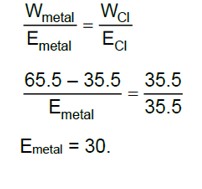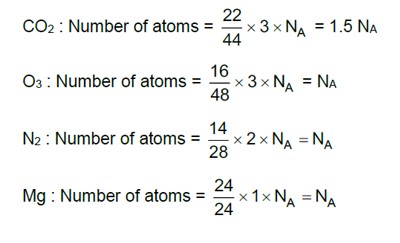1.28. Which one of the following will have largest number of atoms?
(i) 1 g Au (s) (ii) 1 g Na (s) (iii) 1 g Li (s) (iv) 1 g of Cl2(g) (Atomic masses: Au = 197, Na = 23, Li = 7, Cl = 35.5 amu)
1.28. Which one of the following will have largest number of atoms?
(i) 1 g Au (s) (ii) 1 g Na (s) (iii) 1 g Li (s) (iv) 1 g of Cl2(g) (Atomic masses: Au = 197, Na = 23, Li = 7, Cl = 35.5 amu)
-
1 Answer
-
1.28. The number of atoms in each of the given elements are calculated as below:
(i) 1 g Au = 1 / 197 mol = 1/ 197 x 6.02 x 1023 atoms
(ii) 1 g Na = 1/ 23 mol = 1/ 23 x 6.02 x 1023 atoms
(iii) 1 g Li = 1/ 7 mol = 1 / 7 x 6.02 x 1023 atoms
(iv) 1 g of Cl2 = 1/ 71 mol = 1/ 71 x 6.02 x 1023 atoms
Therefore, since the denominator is the smallest in case of Li, 1 g Li has the largest number of atoms
Similar Questions for you
In the medical entrance test NEET, there can be 1 to 3 questions from this chapter. Some year, the Chemistry section of NEET has only one question from this chapter and in some other years, there can be 3 questions.
The following are the key concepts of this chapter: Compound, Elements, Rules, Law of conservation of mass, Addition and Subtraction, Atomic Mass, Law of multiple proportions, and Molecular Mass.
As the name suggests, the first chapter of the NCERT Class 11 Chemistry introduces various basic concepts of chemistry, such as the definition and importance of chemistry, atomic matter and molecular masses, the mole concept, laws of chemical combination, empirical, stoichiometry, and molecular formulas. It also includes the concepts of molarity and molality.
Taking an Exam? Selecting a College?
Get authentic answers from experts, students and alumni that you won't find anywhere else
Sign Up on ShikshaOn Shiksha, get access to
- 65k Colleges
- 1.2k Exams
- 679k Reviews
- 1800k Answers


